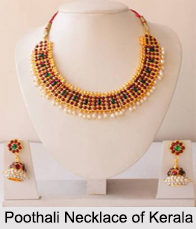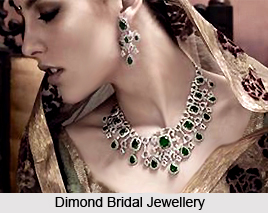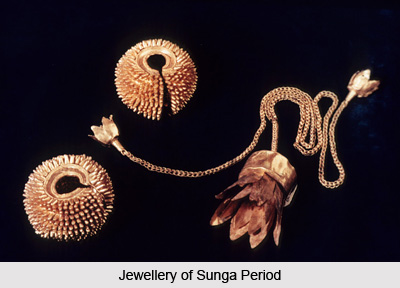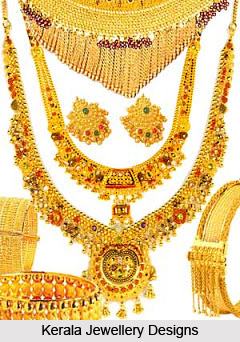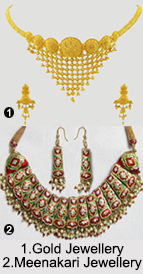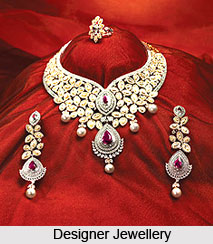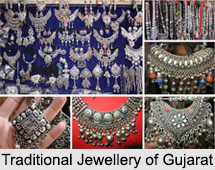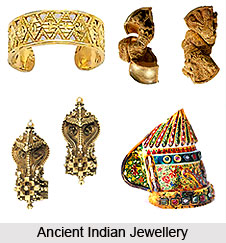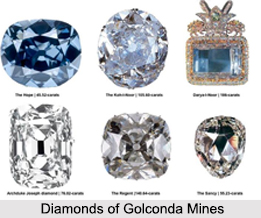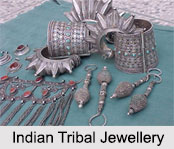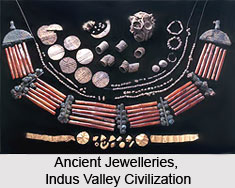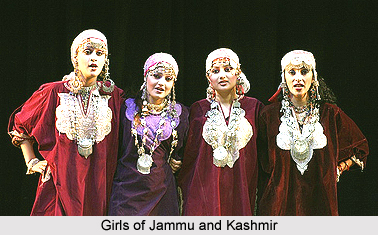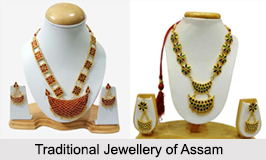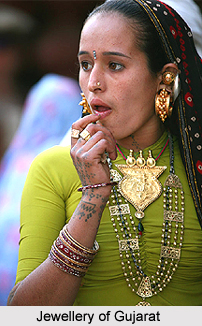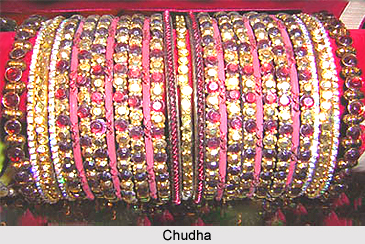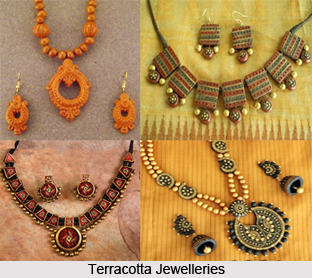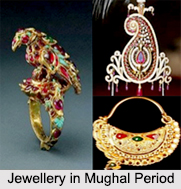 Jewellery in Mughal Period included a variety of ornaments of adornment which were greatly influenced over time. These include necklaces, rings, earrings and a whole lot of other items made of precious stones and gems. During the Mughal rule in India, which began in the 16th century, the art of jewellery making flourished. The Mughal treasury was one of the fullest and best endowed in all of Indian history, and therefore jewellery too must have occupied a place of prominence. Wearing expensive jewellery marked one"s position. The talent and tradition for fine and artistic craftsmanship, coupled with a wealthy and active class of patrons, has also been responsible in shaping Mughal jewellery.
Jewellery in Mughal Period included a variety of ornaments of adornment which were greatly influenced over time. These include necklaces, rings, earrings and a whole lot of other items made of precious stones and gems. During the Mughal rule in India, which began in the 16th century, the art of jewellery making flourished. The Mughal treasury was one of the fullest and best endowed in all of Indian history, and therefore jewellery too must have occupied a place of prominence. Wearing expensive jewellery marked one"s position. The talent and tradition for fine and artistic craftsmanship, coupled with a wealthy and active class of patrons, has also been responsible in shaping Mughal jewellery.
Several Influences on Mughal Jewellery
Various artefacts have been excavated that show the adaptability of both conventional Islamic and traditional Indian styles along with the originality and creativity of artists in various regions. Other than the Mughals, other Islamic powers have also dominated India, which include the Ghaznavids, the Ghurids, the Turkish and Afghan dynasties. Thus the culmination of centuries of Islamic rule was seen in the Mughal dynasty and all these collective influences were witnessed in their life, art, architecture and crafts, including jewellery.
Influence of Rajputs on Mughal Jewellery
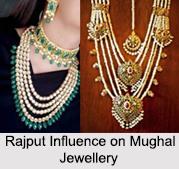 Some of the finest goldsmiths worked under the Mughal patronage. Rajasthan undoubtedly contributed a great deal to the formation of the hybrid Mughal style, as Rajput princesses married Mughal royalty and its rulers had taken high positions at court, both bringing their jewellery and, probably, their craftsmen with them. As a result, Mughal jewellery was influenced by the Rajputs, and thus began the combination of Rajput quaint craftsmanship and Mughal delicate artistry.
Some of the finest goldsmiths worked under the Mughal patronage. Rajasthan undoubtedly contributed a great deal to the formation of the hybrid Mughal style, as Rajput princesses married Mughal royalty and its rulers had taken high positions at court, both bringing their jewellery and, probably, their craftsmen with them. As a result, Mughal jewellery was influenced by the Rajputs, and thus began the combination of Rajput quaint craftsmanship and Mughal delicate artistry.
European Influence on Mughal Jewellery
Some of the earliest Mughal jewellery shows the gradual influence of the 17th Century European style. Jewellery in the Renaissance era also hugely influenced the Mughal pattern, such as the scrolling leaf designs on the inner surface of a thumb ring. A more prominent imposition is evident in turban jewellery where a completely new form seems to have its source in European hat aigrettes. Courtly jewellery carried on the traditions established in the 17th century.
Styles of Mughal Jewellery
The styles in jewellery under the Mughals were an amalgamation of Islamic and Hindu artistic styles. The style of jewellery in Akbar"s era was a hybrid of Iranian and Hindu influences, as would be expected of the emperor of a dynasty whose cultural roots were in Iran. The turban plume known as "Kalgi" or "Figha" and golden bands called "Sarpich" are exactly those seen in contemporary Safavid painting. His necklaces on the other hand are of the kinds listed in Kautilya"s Arthashastra , consisting of pearls, pearls and gems, gold on its own, or gold with pearls and gems. A contemporary work, the Ain-i-Akbari, gives a list of ornaments worn by the women of Hindustan. Some of these may be seen virtually unchanged and worn equally by Muslim ladies. The ornaments include the "Karanphul" which is shaped like the blossom of love-in-the-mist and "Nath", a nose ring in the form of a circular gold wire threaded with a ruby between two pearls or other gemstones.
Evolution of Mughal Jewellery
 Under the rule of Jahangir, fashions at court had undergone a dramatic transformation as can be seen in the paintings of Jahangir. Akbar followed the Iranian fashion by having his upright feather plume at the front of the turban. Jahangir introduced his own, softer, style with the plume weighted down with a large pearl.
Under the rule of Jahangir, fashions at court had undergone a dramatic transformation as can be seen in the paintings of Jahangir. Akbar followed the Iranian fashion by having his upright feather plume at the front of the turban. Jahangir introduced his own, softer, style with the plume weighted down with a large pearl.
Later, Shah Jahan, his son, turned to Europe for an innovative Jigha, which related to the designs of the Dutch jeweller Arnold Lulls. Shah Jahan was greatly impressed by the also jewels wore by James I, as depicted in the portraits brought to the court by Sir Thomas Roe. In the 1618 painting, Shah Jahan, still a prince holds an Indian version of Lulls` designs.
The Mughal emperors conquered most of India, and as a result, their influence extended well beyond North India. The typical Mughal style is visible in the jewellery of Madhya Pradesh, Gujarat, Andhra Pradesh and Odisha. Mughal enamelling and stonework were adopted by other Indian regions for their regional jewellery. Following the Mughals, their style of jewellery-making was carried forward and indulged in by the successive Indian rulers as well.

